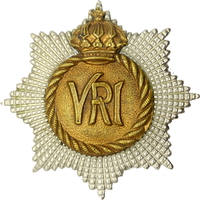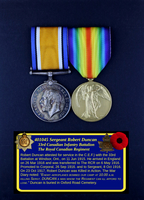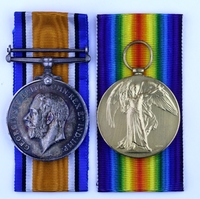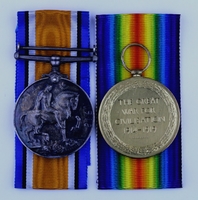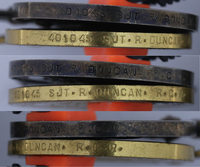
401045 Sergeant Robert Duncan
33rd Canadian Infantry Battalion
The Royal Canadian Regiment
By: Capt (ret'd) Michael M. O'Leary, CD, The RCR
Robert Duncan was born in Partrick, Glasgow, Scotland, on 12 Oct 1895.
Duncan attested for service in the Canadian Expeditionary Force (C.E.F.) with the 33rd Overseas Battalion at Windsor, Ont., on 11 Jun 1915. A 19-year 9-month old optician, Duncan was described on his attestation paper as 5 feet 10 inches tall, with a 36 1/2-inch chest, a fair complexion, hazel eyes, and light brown hair. His religious denomination was Presbyterian. Duncan identified his brother, Mr. Dan Duncan, 6797 "D" Company, 3rd Battalion, Argyll & Sutherland Highlanders [British Army], as his next of kin. On attesting with the 33rd Battalion, Duncan was given the regimental number 401045.
In the London Advertiser edition of Wednesday, June 16, 1915, there is a list of new recruits joining the ranks of the 33rd Battalion. Robert Duncan is listed among them and shown as a soldier of "D" Company to start his military service.
The 33rd Battalion, C.E.F., was authorized on 7 Nov 1914 and recruited in southwestern Ontario. The battalion was mobilized at London, Ontario, where it conducted training at Wolseley Barracks.
Before sailing for England, in March 1916, Duncan set up a monthly pay assignment of $20. This was sent to Mrs. G. Cunningham, 1735 E. 32nd Street, Cleveland, Ohio, USA. This pay assignment would be maintained until October 1916. Mrs Cunningham's address recorded in Duncan's service record changed to 683 Ossington Ave., Toronto, Ont., in late 1917. Duncan's relationship to Mrs. Cunningham is not identified in his service record.
Duncan embarked ship in Canada on 17 Mar 1916. Crossing the Atlantic aboard the S.S. Lapland, he disembarked with the 33rd Battalion in England on 26 Mar 1916. The battalion was redesignated the 33rd Reserve Battalion on 6 Apr 1916 and provided reinforcements until 6 Jul 1916 when its remaining personnel were absorbed by the 36th Battalion.
On 22 Apr 1916, Duncan was promoted to the rank of Lance Corporal while the 33rd Res. Bn. was at Shorncliffe. Two weeks later, on 6 May 1916, he was transferred to The RCR. In order to proceed overseas as a reinforcement, it was necessary that Duncan request to relinquish his rank and revert to the rank of private. This was a common requirement as the units in France did not want non-commissioned officers without experience in the trenches. The units promoted to fill NCO vacancies from within their ranks and any man who proved himself would have the opportunity to regain rank once they had front line experience.
Duncan arrived at the Canadian Base Depot (C.B.D.) at Havre on 8 May 1916. Having entered the theatre of war, he was taken on the strength of The RCR as a reinforcement from the 33rd Res. Bn.
On 22 Jul 1916, Duncan was re-appointed to the rank of Lance Corporal. A few weeks later, on 2 Aug 1916, he was sent On Command (i.e., a temporary duty assignment without changing parent unit) to the Canadian Corps Officers School. His service record does not record details of this assignment.
Duncan's rise through the ranks continued. On 26 Sep 1916 he was appointed Acting Corporal (with pay), a rank that was later made substantive and back-dated to 23 Jul 1916. In the unit orders published on 20 Jan 1917, not only was Duncan's promotion to Corporal confirmed, but also a promotion to Sergeant effective from 8 Oct 1916.
Granted 10 days Leave to England, Duncan enjoyed that break from front line service between 27 Sep and 13 Oct 1917 when he rejoined from leave. This would be Duncan's only period of leave.
On 23 Oct 1917, Robert Duncan was Killed in Action.
The C.E.F. War Diary of The Royal Canadian Regiment records the following for 23 and 24 Oct 1917:
"23-10-17. - PREDELLES.
"The Battalion moved off at 2.15 a.m. and entrained at CAESTRE arrived YPRES 6.30 a.m. Raining Heavily. Marched to St JEAN AREA where men got under cover until early afternoon when the Battalion moved forward to WIELTJE C. CAMP. (Sheet 28C.29.a.) into bivouacs vacated by the 58TH battalion. Sandbags were drawn from the R.E. and before night everyone was fairly comfortable in bivouacs or tents. The place is very muddy and the rain almost continual. 1 other rank killed in action.
"24-10-17. - ST JEAN AREA.
"The day was fine with good visibility. Enemy aeroplanes bombed our camp at 10.00 a.m. killing Sergt. DUNCAN a man whom the Regiment can ill afford to lose. Three other raids followed in the course of the day but no more bombs fell in our lines. 300 all ranks on carrying parties to the support lines."
While the War Diary mentions a soldier killed on each day, 23 and 24 Oct 1917, it appears that both are references to Duncan's death on the 23rd. Between 1 and 29 Oct 1917, The RCR had only eight fatal casualties. Two of these were on the 4th and 8th of October, Privates H.E. Wynn (715027, KIA) and J.A. Butterworth (478903, Missing/KIA), respectively. Two died on 26 Oct 1917, Privates J. Dixon (401163, DOW, wounded 15 Oct) and A.E. Sharpe (817704, DOW, wounded 26 Oct). There was one more on 27 Oct, Pte. G. Vitcko (478792, KIA) and another on 29 Oct, Pte. A.T. Graham (261306, KIA). Sadly, twenty-nine others would fall on 30 and 31 Oct 1917.
Between Butterworth's death on 8 Oct and Dixon and Sharpe on 26 Oct there were only two casualties of The RCR. These were Robert Duncan on 23 Oct 1917 and Pte. Carl Arnaud Johnson (902372) on 24 Oct 1917. Johnson died of shrapnel wounds to his right leg, chest and abdomen at No. 42 Casualty Clearing Station which was located near Aubigny in the Pas de Calais France, which is 70 Kilometres from Wieltje Camp where the Regiment was "resting" and providing carrying parties. He had been wounded on 17 Oct 1917.
The only fatality in unit lines at the time was Robert Duncan. Despite the minor confusion on the manner in which his death is noted in the War Diary, the fact that he was mentioned by name and the way it was presented speaks highly of his performance of duties: "… a man whom the Regiment can ill afford to lose."
The first volume of regimental history published by The RCR, The Royal Canadian Regiment, 1883-1933 (Fetherstonhaugh, 1936), on page 301, provides the following on the Regiment's activities on the day before and of Duncan's death:
"Having assumed command of the Battalion, one of Major Willets's first duties was to prepare the unit for an inspection of the 7th Brigade by the Honorary Colonel of The Royal Canadian Regiment, Field-Marshal His Royal Highness the Duke of Connaught. Parading to a field near the village of Barre on the morning of October 22, the battalions of the Brigade drew up and were inspected by the Duke, who was accompanied by his son, Prince Arthur of Connaught, then serving on the General Staff of the Canadian Corps. Fine weather prevailed and the units, which shared in the universal regard of Canadians for their former Governor-General, vied with one another in the smartness with which their march past was conducted.
"On the day after His Royal Highness's inspection, the Battalion paraded at 2.15 a.m. and marched to Caestre, where it entrained for Ypres. Arriving at 6.30 a.m. in heavy rain, the unit detrained and marched to the St. Jean area, whence, in the afternoon, it moved forward and took over from the 58th Canadian Battalion bivouac positions in Camp C at Wieltje. One man was killed by shelling of the camp that day, and on the morrow Sergt. Robert Duncan, whom the unit could ill afford to lose, was killed when the camp was bombed by German aeroplanes. Each day in this short period, the Regiment furnished 300 men to carry supplies into the forward area, and on October 26, when the 8th and 9th Canadian Brigades attacked, 150 men were employed as stretcher-bearers and 100 in carrying "bath mats" up to the old front line. In the deep mud of the area, work of this nature imposed a strain which reduced the strongest men to something approaching physical exhaustion, and an indication of the, danger incurred is afforded by the Battalion's losses, which quickly reached a total of 3 killed, 2 missing, and 24 wounded."
The regimental history repeats the error in the War Diary, matching the phrasing describing Sgt, Duncan exactly and establishing that it had been a reference document for those paragraphs.
An officer's diary (unattributed through the loss of the cover sheet) which survives in the collection of The Royal Canadian Regiment Museum provides a description of the working conditions for the Regiment on the days following HRH's inspection:
"On 22nd [Oct] H.R.H. The Duke of Connaught, Colonel of the Regiment, accompanied by H.R.H. Prince Arthur, inspected the brigade at Barre. The following day the battalion marched to Caestre and entrained for Ypres. From there they marched first to the St Jean Area and then to the Weiltje Area where they took over bivouacks, tents on sandbags, from 58th Cdn Bn. While there much heavy hostile bombing took place, this with heavy rain made conditions extremely uncomfortable. Until the end of the month the battalion carried out valuable working, carrying and stretcher bearer parties for the Heavy Artillery and 8th Cdn Infty Bde in the Passchendaele Area.
"The conditions at this time were really terrible, the annihilating fire of our guns, the intense bombing day and night had pockmarked the surface of the ground as never before, the heavy rain on this turned the area into a sea of mud.
"Communication was difficult and erratic and caused the position to be critical at all times. Runners were never despatched with messages until all other means had failed for fear of them becoming lost in the wilderness of shell holes or swallowed up in the mud. Visual signalling was much used when telephone wires had been broken and the small portable Lucas electric lamp proved invaluable.
"Carrying parties and pack animals were the only means of bringing up supplies, ammunition, etc., and everywhere tracks had to be made. Needless to say these were well marked by the enemy and a crumped bath mat often meant great delay and sometimes a minor disaster.
"Whenever possible roads and light railways were pushed well forward. The evacuation of the sick and wounded was naturally very difficult under these conditions and necessitated long carries.
"The enemy had strongly fortified the last of the high ground to command Ypres, and hung on tenaciously with the aid of numerous machine guns housed in heavy concrete emplacements commonly known as pillboxes.
"On top of all this the enemy made use of gas including a new form of gas shell containing mustard gas. This was most difficult to recognize with the result that many casualties occurred by men not donning their box respirators until too late. The liquid of this gas also percolated through the clothing and caused large sores and burns so that casualties were caused even with respirators on. This immediately gave rise to rumours that the respirator was not efficient, it took a considerable time to impress the troops to the contrary."
With hundreds of soldiers on working parties each day, it is a small miracle that more men were not lost to the terrain and enemy action during those days in the Weiltje Area. Among the CEF documents held by Library and Archives Canada is a Circumstances of Death record for Duncan. The details under circumstances of casualty read:
"Killed in Action"
"During military operations in the vicinity of St. Jean at about 11 o'clock on the morning of October 23rd 1917, he was instantly killed by a bomb, dropped from an enemy aeroplane."
Commonwealth War Graves Commission documents show that Duncan's first place of burial was west of the town of Wieltje, Belgium in what was then known as Wieltje Cemetery. The location, given as "Plot 1, Row A, Grave No. 7" was located on map sheet 28 N.W., C.28.A.8.8, which is now farm fields. Duncan's final resting place is close by to the south, at Oxford Road Cemetery, "1 1/2 miles North East of Ypres, Belgium." Robert Duncan is the only Royal Canadian in this cemetery of 852 burials, 556 of which are identified.
For his service in the C.E.F., Duncan was entitled to receive the British War Medal and the Victory Medal. These were despatched to his parents at 10 Fifth Ave., Princess Louise Rd., Blyth, Surburton, Northumberland, Eng., on 14 Jul 1922. Duncan's parents would also receive the Memorial Plaque and Scroll and a silver Memorial Cross for his mother. The plaque and cross would also be despatched in 1922.
Pro Patria
Visit a randomly selected page in The O'Leary Collection (or reload for another choice):
- The O'Leary Collection; Medals of The Royal Canadian Regiment.
- Researching Canadian Soldiers of the First World War
- Researching The Royal Canadian Regiment
- The RCR in the First World War
- Badges of The RCR
- The Senior Subaltern
- The Minute Book (blog)
- Rogue Papers
- Tactical Primers
- The Regimental Library
- Battle Honours
- Perpetuation of the CEF
- A Miscellany
- Quotes
- The Frontenac Times
- Site Map
QUICK LINKS
The O'Leary Collection—Medals of The Royal Canadian Regiment
Newest additions:
![]()
![]() SB-12725 Private Henry "Hank" Ard
SB-12725 Private Henry "Hank" Ard ![]()
WIA at Hill 187, Died of Wounds in Japan
![]()
![]() 2355331 Lance Corporal Albert Lorking
2355331 Lance Corporal Albert Lorking
Wounded in action, later a War Amps representative.
![]()
![]() 4334 / 477996 Pte Isaac Hamilton Wilcox
4334 / 477996 Pte Isaac Hamilton Wilcox
Permanent Force, South Africa, and C.E.F.
![]()
![]() 477019 Private Harold Ashcroft
477019 Private Harold Ashcroft
Transferred to the Tunnelers.
![]()
![]() 734231 Private Clark D. Thompson
734231 Private Clark D. Thompson ![]()
The older Thompson brother, killed in action.
![]()
![]() 733849 Private Norman Parker Thompson
733849 Private Norman Parker Thompson
The younger Thompson brother; post-war service in the Special Guard.
![]()
![]()
![]() A305 / 400305 Private Andrew Walker
A305 / 400305 Private Andrew Walker ![]()
"Previously reported Wounded, now Killed in Action."
![]()
![]() 823298 Pte Thomas Patrick Steele, M.M.
823298 Pte Thomas Patrick Steele, M.M. ![]()
… for gallant conduct in the field …
![]()
![]() P13066 Sergeant Harold Thompson
P13066 Sergeant Harold Thompson
Instrumental Soloist for over 20 years of Canadian Army service.
![]()
![]() 9609 / 477728 Private Albert Edward Piper
9609 / 477728 Private Albert Edward Piper
"Arrived from England as a STOWAWAY …"
